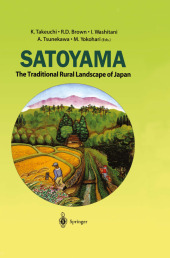 Neuerscheinungen 2012Stand: 2020-01-07 |
Schnellsuche
ISBN/Stichwort/Autor
|
Herderstraße 10
10625 Berlin
Tel.: 030 315 714 16
Fax 030 315 714 14
info@buchspektrum.de |

R. D. Brown, K. Takeuchi, A. Tsunekawa, I. Washitani, M. Yokohari
(Beteiligte)
Satoyama
The Traditional Rural Landscape of Japan
Herausgegeben von Takeuchi, K.; Brown, R.D.; Washitani, I.; Tsunekawa, A.; Yokohari, M.
Softcover reprint of the original 1st ed. 2003. 2012. xi, 229 S. XI, 229 p. 235 mm
Verlag/Jahr: SPRINGER, BERLIN 2012
ISBN: 4-431-67980-4 (4431679804)
Neue ISBN: 978-4-431-67980-6 (9784431679806)
Preis und Lieferzeit: Bitte klicken
Japan´s traditional and fragile satoyama landscape system was developed over centuries of human life on mountainous island terrain in a monsoon climate. The carefully managed coppice woodlands on the hillsides, the villages strung along the base of the hills, and the carefully tended paddy fields of rural Japan made possible the sustainable interaction of nature and humans. Radical changes in the middle of the twentieth century led to the abandonment of satoyama landscapes which now are being rediscovered. There is a new realization that these woodlands still play a vital role in the management of the Japanese landscape and a new determination to manage them for the future. This multifaceted book explores the history, nature, biodiversity, current conservation measures, and future uses of satoyama. The information presented here will be of interest in all parts of the world where patterns of sustainable development are being sought.
Preface Kazuhiko Takeuchi Contributors Chapter 1. Ideological Contribution of Satoyamas Robert D. Brown and Makoto Yokohari Introduction International Perspective on Coppice Woodlands Contributions to the book Contributions of the book Chapter 2. The Nature of Satoyama Landscapes 2.1 Satoyama Landscapes as Managed Nature Kazuhiko Takeuchi 2.2 Satoyama Landscapes and Conservation Ecology Izumi Washitani 2.3 Citizen Conservation of Satoyama Landscapes Noboru Kuramoto 2.4 Environmental Policy and Satoyama Landscapes Yoshinobu Kitamura Chapter 3. Satoyama Landscape Transition 3.1 Transition of Satoyama Landscapes in Japan Atsushi Tsunekawa 3.2 Satoyama Landscape Transition in the Kanto Area Atsushi Tsunekawa and Tsutomu Bessho 3.3 Satoyama Landscape Transition in the Kansai Area Junko Morimoto and Yukihiro Morimoto 3.4 Mechanisms of Satoyama Landscape Transformation Hideharu Kurita and Makoto Yokohari Chapter 4. Biological Diversity in Satoyama Landscapes 4.1 Conserving Biological Diversity Noboru Kuramoto 4.2 Species Diversity in Satoyama Landscapes Youichi Sonoda and Izumi Washitani 4.3 Wetland Environments and Biodiversity in the Hills Yukihiro Morimoto 4.4 Birds of Prey Living in Yatsuda and Satoyama Atsuki Azuma Chapter 5. Approaches to Satoyama Conservation 5.1 Nation-Wide Partnerships for Satoyama Conservation Shigesato Nakagawa 5.2 Coppice Woodland Maintenance by Volunteers Noboru Kuramoto and Asou Yoshimi 5.3 Regeneration of Satoyama Landscapes Yoshiko Kitagawa 5.4 Restoration of Aquatic Ecosystems Izumi Washitani Chapter 6. Biological Resources 6.1 Biological Resources in Village Life Kenji Iiyama 6.2 Coppice-Wood as an Energy Source Shigesato Nakagawa 6.3 Nature Study in Satoyama Landscapes Shigesato Nakagawa Chapter 7. Long-term Strategy for Satoyama Conservation 7.1 Strategic Management of Satoyama Landscapes Atsushi Tsunekawa 7.2 Legal Systems for Satoyama Landscape Conservation Yoshinobu Kitamura 7.3 National Land Planning of Satoyama Landscapes Kazuhiko Takeuchi References Glossary of Terms Regional and Prefectural Map of Japan Index


